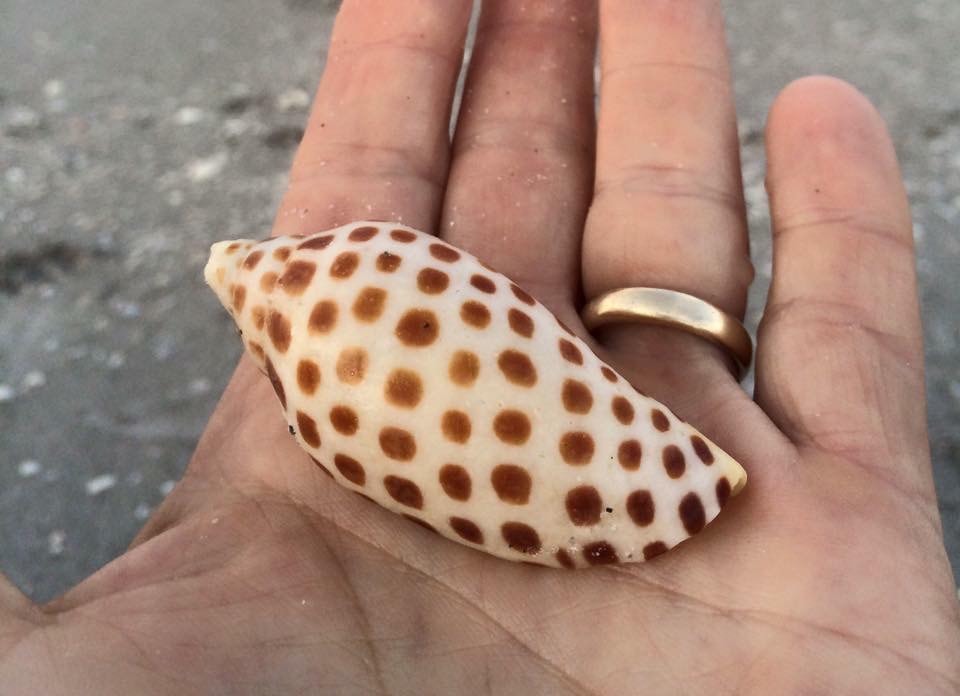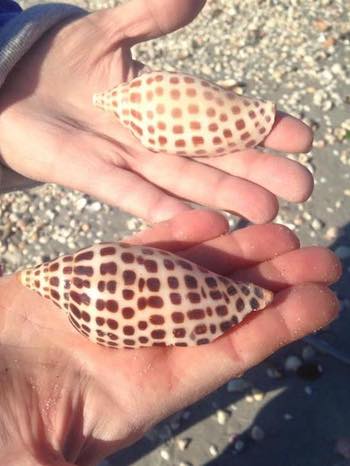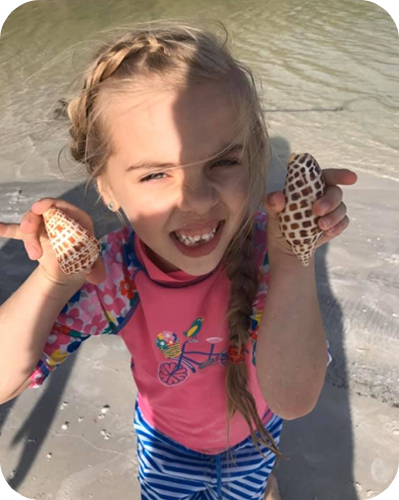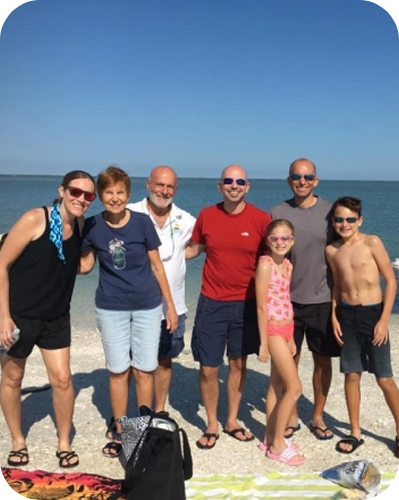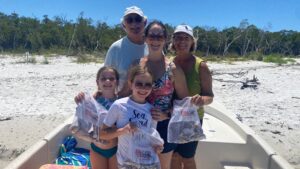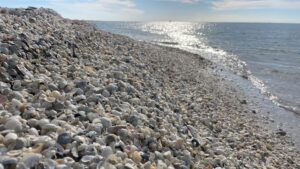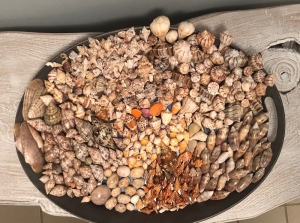Every year, hundreds of excited beachcombers swarm Sanibel Island in search of the elusive Junonia shell. Armed with flashlights and enthusiasm, tourists trawl the sand, trying to spot those distinctive brown spots.
If you’re new to shell finding or collecting, you may be wondering what all the fuss is about. Even if you’re a Beachcomber with some experience, you still may not know exactly why the Junonia is so popular. What has propelled it to this almost mythical status?
The Junonia is gorgeous and rare. There is little available information about the creature that once occupied the shell, and what we do know raises more questions than answers. But on the whole, the story of the Junonia is fascinating.
In this piece, we’ll answer all your burning questions about the Junonia shell. Read on to find out about the snail, the shell, and the journey it takes to get to you.

What Is a Junonia?
The Scaphella Junonia is a species of marine gastropod mollusk. In easier terms: a sea snail! The term gastropod refers to the way these mollusks move: with a single, muscled “foot”.
The snails use this foot as their primary mode of transportation. It allows them to burrow, flap, swim, and climb! All of the Junonia’s innards and organs are inside their spotted shell.
The Junonia’s body and shell are both marked with a distinctive dot pattern. The shell is usually a creamy white with brown dots, allowing the snail to camouflage with the ocean floor. The snail’s body is yellow in color, marked by similar black dots.
These snails are small in stature. The largest Junonia shell ever found was only six inches long! Their usual size is anywhere between 1 and 4 inches.
The Junonia snail pokes shyly out of its shell, and upon its death, detaches from the shell entirely. Then, once a storm starts up, the empty shell is carried to the sandy shore, waiting for an excited shell-seeker to turn up.

The Junonia Shell
Alright, let’s talk about the coveted shell itself. As mentioned, the shell is cream-colored with brown spots. The shell is spindle-shaped and swirls itself into a point.
The shell aperture is smooth but may have one small set of teeth. The aperture usually makes up about 3/4″ of the shell’s length! The Junonia’s inner shell is a mottled pink and purple, almost replicating the spotted pattern on the outside.
The whorls leading up to the shell’s point are usually ridged. The Junonia shell has an interesting texture, looking not unlike a thumbprint. These ridges are more concentrated toward the point of the shell but spread out closer to the bottom.
Though these shells are pretty durable, they’re still breakable. Since Junonia shells are often washed up by a storm or hurricane, they sometimes come to shore in pieces. Finding a whole Junonia is a stroke of luck.
Junonia is a popular decor piece for beach enthusiasts. You can find ornaments, pillows, and other personalized Junonia items in many Florida gift shops. The town of Sanibel is entirely branded around the Junonia, and for good reason (but more on that later)!

What’s in a Name?
The word “Junonia” refers to the Roman goddess Juno. Juno was the Roman counterpart to Hera; she was the wife to Jupiter (Zeus in Greek mythos) and ruled as Queen of the Gods. Juno was the protector of women and the home and was portrayed as a powerful woman who towered over all those who dared underestimate her.
This makes the Junonia a romanticized creature. The sea snail represents grace and power, self-sufficiency, and strength. Their highly decorated shell is known to be durable, as it must make a long journey to shore.
The reference to Juno is fitting for this rare snail. They live long lives and make their homes so far underwater, that a shell washing to shore is nothing short of a miracle. The discovery of each shell feels like a blessing from Juno herself.
BOOK YOUR SHELLING TOUR!
Are You Looking For A Guided Seashell Finding Tour in Southwest Florida? Book With Sand Dollar Shelling!
The Junonia Way of Life
Not much is known about the way Junonia snails live! The shells are highly prized, but there is not a large amount of research about how they live. There’s a burgeoning body of research on the Junonia, but so far, only one museum is devoting time to studying the creature!
We do know that Junonia snails live in water 60-120ft deep, and usually 40-60ft offshore. They live on the bottom of the ocean, captivated by warm waters. The snail belongs to the family Voltae, and therefore is a carnivorous snail.
Junonia is a small predator, and feeds mostly on other gastropods. They’re a swift hunter. It may be hard to imagine a meat-eating marine snail, but that’s part of the Junonia appeal.
We have very little information about the average lifespan of a Junonia. We do know they’re mortal! How else would we get their shells?
The mystery behind the Junonia is part of what makes it so appealing. When gazing upon a found shell, we can only wonder what the snail’s life cycle was like. The shell is from another world entirely, one wholly unfamiliar to ours.
From their simple life in the deep sea to their unlikely journey to shore, Junonias represent the best qualities of beachcombers. They are strong, tenacious, and detailed. No wonder so many shell hunters feel a deep connection to the Junonia.
What Makes Junonia Shells So Rare?
Junonia is one of the rarest shells to find. It’s highly coveted among beachcombers.
Because Junonia snails live on the ocean floor, their shells aren’t likely to wash up on the beach. Once a Junonia dies, its shell is more likely to stay buried than to travel the 60 to 150 feet to the sand.
Therefore, it takes a thunderstorm or a strong current to take Junonia shells to shore. Junonia shells can sometimes be brought to shore by shrimping boats as bycatch. Either way, they’re hard to find barring a recent hurricane.
Junonia shells are also fairly small in size. They can be easy to overlook when shelling and could get swept back into the surf. This makes a Junonia find especially momentous.
The rarity of Junonia shells helps them to take on an almost mythical status. People see the Junonia as a beach-based rite of passage, or a holy symbol about life itself. The rarity contributes to and supports its beauty.
Where to Find a Junonia Shell
Junonia shells can be found on beaches along the Gulf of Mexico. They are most commonly found in Southwest Florida. The world’s largest Junonia was found in Florida, and today lives in Sanibel!
If you’re looking to maximize your shell hunt (and find shells other than Junonias), visit Marco and Sanibel Islands. This locale is famous among beachcombers as the Holy Land of Shells, at least in the USA!
If you’re a beginner shell finder looking to maximize your island experience, look into a shelling tour. Our shelling company will take you on a tour of the most plentiful beaches. For more information, call (239) 301-8913.
Shelling trips are a great adventure for novice and experienced beachcombers alike. They’re also safe enough to bring kids, and offer them the experience of a lifetime.

Why Southwest Florida?
Marco Island and Sanibel Island are great shelling destinations. Hundreds of shells end up washing onto their shores. An abundance of species are represented in the surf.
But why? What makes these islands such a magnet for shells, especially rare ones?
The secret is that Sanibel Island runs perpendicular to the state of Florida. Its sands meet the water at a 90-degree angle from the mainland. This causes the water to flush downward, leaving a bevy of shells behind.
However, Sanibel Island is a little too well-known among shell enthusiasts. It’s something of a “drive-up beach”, and the shore is thoroughly combed by midday. The town of Sanibel encourages tourism, which leads to a crowded beach.
If you want to have a shelling experience without the crowds, explore Marco Island. Marco Island runs at an angle to Florida proper, and includes many tiny islands that are accessible only by boat.
When taking a tour of Marco Island, you’ll get to explore multiple small islands that gather large amounts of shells. The shape of Marco Island traps the current and delivers plenty of shells to shore.
If you can schedule your trip after a big storm, your chances of finding a Junonia are much higher!
The Junonia Subspecies
Two subspecies of Junonia shells have been found outside of Florida. They have slight color variations from the common Junonia.
The Scaphella junonia butleri is found off of the Yucatan. Its shell is a lighter cream, and it has smaller spots. The Butleri looks almost like a sun-faded Junonia.
The Scaphella junonia johnstoneae is found in Alabama waters. It was discovered by a Harvard scientist, and named for an Alabama-born marine biologist. The Johnstoneae is also the state shell of Alabama!
The Johnstoneae’s spots are darker than the Junonia’s, and closer together. Some Jonstoneae shells seem almost striped due to the closeness of the markings.
Having two discovered Junonia subspecies is exciting! This suggests that there could be many more of these gastropods out there. They’re just waiting to be discovered by an early-rising beachcomber.
What a Junonia Shell Is Worth
Junonia shells are a hot commodity on the shell-collecting market. They’re highly sought-after for their beauty and rarity. People who may not be able to visit Sanibel or Marco Island may still want to own one.
Smaller Junonia shells, measuring three inches or smaller, could sell for $30 to $40. Larger shells, measuring four inches or more, could go for $80 to $100! This all depends on the quality of the shell and the enthusiasm of the buyer.
The Junonia subspecies will go for higher prices, though it’s difficult to estimate. Since they’re only found in Alabama and Yucatan waters, they sell quickly. Many shell collectors do their business behind closed doors, so we can only assume they’d be valuable!
These unique shells are worthy of the admiration they receive. But who could ever put a price on the experience of picking a Junonia out of the sand with your own bare hands?
Can You Buy Junonia Shells?
Well… sure, but what’s the fun in that? If you’re ready to drop a Benjamin on a large Junonia shell, we won’t stop you. But hear us out first.
The appeal of a Junonia shell is not in ownership. The appeal of a Junonia shell is the trill of seeking it. When you merely buy the shell, you lose the story.
Your Junonia shell traveled hundreds of miles to get to shore. It traversed stormy seas, crashed against hundreds of other shells, to finally come to rest on the sand. It laid there for who knows how long, waiting for you to find it.
When you alienate yourself from the shell’s environment, you lose your connection to the sea. Finding the shell in its ecosystem is powerful. It reminds you of how much there still is to discover about our world.
Sure, it will feel satisfying to hold a Junonia in your hands no matter what. But the moment of earthly connection you feel while beachcombing is unparalleled. You remember, if just for a moment, that the world is larger than your immediate atmosphere.
This is why we encourage taking a shelling tour and letting experts guide you. We can take you to your next great find, and you’ll feel better having earned it. At Sand Dollar Shelling, our guides never pick up a shell: they leave the treasure for you to find.
A Shell Hunt Is A Worthy Adventure
We hope this guide has answered every question you had about Junonia shells. If you didn’t have many questions about the shells, then we hope you enjoyed learning about them! The mystery and mythos surrounding Junonia shells makes them especially alluring.
We at Sand Dollar Shelling would love to help make your dreams come true. Our guides are knowledgeable, professional, and devote themselves to helping you. Give us a call to schedule your adventure.

